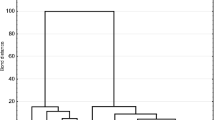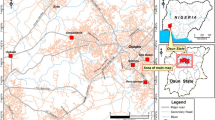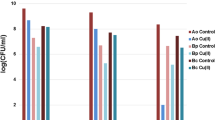Abstract
Because of concerns about the toxicity of lead (Pb), the use of antimony (Sb), indium (In), silver (Ag), and other heavy metals are on the increase as its replacement in many kinds of industrial products, particularly in solders. In the present study, effects of Pb, Cu, Sb, In, and Ag contamination on bacterial growth inhibition in PTYG (peptone, tryptone, yeast extract, glucose) liquid media, soil dehydrogenase activity, concentrations and compositions of phospholipids fatty acids (PLFA) were assessed. Survival rates of bacterial colony-forming units were lower in the presence of various concentrations of Pb, Cu, Sb, In, Ag, Zn and Ni than in their absence. Soil dehydrogenase activity in Arenic Eutric Regosol was much decreased when the concentrations of Pb and Cu were 50 times their natural abundance and when Ag was at 100 times its natural abundance. Soil dehydrogenase activity was also much decreased in Eutric Cambisol when Cu was 50 times, and Ag was 100 times, their natural abundances. In contrast, Sb and In did not affect soil dehydrogenase activity at any concentration or in any type of soil. Concentrations and composition of PLFA did not show any conspicuous change. Cu, Sb, In and, especially, Ag, which are increasingly being used to replace Pb, should be considered to be potentially toxic. However, when evaluating the impact of waste metals on the environment, heavy metal solubility, speciation and interaction with organic matter in soil must be considered.
Similar content being viewed by others
References
Adriano, D. C.: 1986, Trace Elements in the Terrestrial Environment, Springer, New York.
Ainsworth, N., Cooke, J. A. and Johnson, M. S.: 1990, ‘Distribution of antimony in contaminated grassland: 1-vegetation and soils’, Environ. Pollut. 65, 65–77.
Asami, T.: 2001, The Harmful Metal Pollution of Japanese Soil to Show by the Data, Agune Gijutsu Center, Tokyo (in Japanese).
Aoyama, M. and Nagumo, T.: 1997, ‘Effects of heavy metal accumulation in apple orchard soils on microbial biomass and microbial activities’, Soil Sci. Plant Nutr. 43, 601–612.
Bååth, E., Frostegård, A. and Fritze, H.: 1992, ‘Soil bacterial biomass, activities, phopholipid fatty acid pattern, and pH tolerance in an area polluted with alkaline dust deposition’, Appl. Environ. Microbiol. 58, 4026–4031.
Bååth, E., Frostegård, å., Diaz-Raviña, M. and Tunlid, A.: 1998, ‘Microbial community-based measurements to estimate heavy metal effects in soil: The use of phospholipids fatty acid patterns and bacterial commuity tolerance’, Ambio 27, 58–61.
Bligh, E. G. and Dyer, W. J.: 1959, ‘A rapid method of total lipid extraction and purification’, Can. J. Biochem. Physio. 37, 911–917.
Bossio, D. A., Scow, K. M., Gunapala, N. and Graham, K. J.: 1998, ‘Determinants of soil microbial communities: effects of agricultural management, season, and soil type on phospholipid fatty acid profiles’, Microb. Ecol. 36, 1–2.
Brookes, P. C. and McGrath, S. P.: 1984, ‘Effects of metal toxicity on the size of the soil microbial biomass’, J. Soil Sci. 35, 341–346.
Campbell, C. D., Hird, M., Lumsdon, D. G. and Meeuseen, J. C. L.: 2000, ‘The effect of EDTA and fulvic acid on Cd, Zn, and Cu toxicity to a bioluminescent construct (pUCD607) of Escherichia coli’, Chemosphere 40, 319–325.
Campbell, P. G. C., Stokes, P. M. and Galloway, J. N.: 1983, ‘The effect of atmospheric deposition on the geochemical cycling and biological availability of metals’, Proceedings of the International Conference on Heavy Metals in the Environment, Heidelberg, Germany, CEP Consultants, Edinburgh, UK, pp760–763.
Casida, L. E., Klein, D. A. and Santoro, T.: 1964, ‘Soil dehydrogenase activity’, Soil Sci. 98, 371–376.
Cavigelli, M. A., Robertson, G. P. and Klug, M. J.: 1995, ‘Fatty acid methyl ester (FAME) profiles as measures of soil microbial community structure’, Plant Soil 170, 99–113.
Cela, S. and Sumner, M. E.: 2002a, ‘Soil zinc fractions determine inhibition of nitrification’, Water, Air, and Soil Pollut. 141, 91–104.
Cela, S. and Sumner, M. E.: 2002b, ‘Critical concentrations of copper, nickel, lead, and cadmium in soils based on nitrification’, Comm. in Soil Sci. Plant Anal. 33, 19–30.
Chander, K. and Brookes, P. C.: 1991, ‘Is the dehydrogenase assay invalid as a method to estimate microbial activity in copper-contaminated soils’, Soil Biol. Biochem. 23, 909–915.
Chang, F. H. and Broadbent, F. E.: 1981, ‘Influence of trace-metals on carbon-dioxide evolution from a Yolo soil’, Soil Sci. 132, 416–421.
Chang, F. H. and Broadbent, F. E.: 1982, ‘Influence of trace-metals on some soil-nitrogen transformation’, J. Environ. Qual. 11, 1–4.
Cornfield, A. H.: 1977, ‘Effects of addition of 12 metals on carbon dioxide release during incubation of an acid sandy soil’, Geoderma 19, 199–203.
Dahlin, S., Witter, E., Maartensson, A., Turner, A. and Bååth, E.: (1997), ‘Where’s the limit? Changes in the microbiological properties of agricultural soils at low levels of metal contamination’, Soil Biol. Biochem. 29, 1405–1415.
Dai, J., Becquer, T., Rouiller, J. H., Reversat, G., Bernhard-Reversat, F. and Lavelle, P.: 2004, ‘Influence of heavy metals on C and N mineralisation and microbial biomass in Zn-, Pb-, Cu-, and Cd-contaminated soils’, Appl. Soil Ecol. 25, 99–109.
Danecka-Bialek, M. and Domka, F.: 1991, ‘The effect of heavy metal ions on the activity of denitrifiers from Bacillus genus’, Environ. Protec. Eng. 17, 75–82.
Dietl, C., Wäber, M., Peichl, L. and Vierle, O.: 1996, ‘Monitoring of airborne metals in grass and depositions’, Chemosphere 33, 2101–2111.
Doelman, P.: 1986, ‘Resistance of soil microbial communities to heavy metals’, in V. Jensen, A. Kjøller and L.H. Sørensen, (eds), Microbial Communiies in Soil, FEMS Symposium 33, Elsevier, Copenhagen, Denmark, pp. 369–384.
Ewers, U.: 1991, ‘Standards, guidelines, and legislative regulations concerning metals and their compounds’, in E. Merian, (ed), Metals and Their Compounds in the Environment, VCH, New York, pp. 687–711.
FAO, ISRIC and ISSS: 1998, World reference base for soil resources. World Soil Resources Reports, 84, FAO, Rome, Italy.
Flynn, H. C., Meharg, A. A., Bowyer, P. K. and Paton, G. I.: 2003, ‘Antimony bioavailability in mine soils’, Environ. Pollut. 124, 93–100.
Frostegaård, A. and Bååth, E.: 1996, ‘The use of phospholipid fatty acid analysis to estimate bacterial and fungal biomass in soil’, Biol. Fertil. Soils 22, 59–65.
Frostegård, A. Tunlid, A. and Bååth, E.: 1996, ‘Changes in microbial community structure during long-term incubation in two soils experimentally contaminated with metals’, Soil Biol. Biochem. 28, 55–63.
Frostegård, A., Tunlid, A. and Båårth, E.: 1991, ‘Microbial biomass measured as total lipid phosphate in soils of different organic content’, J. Microbiol. Methods 14, 151–163.
Giller, K. E., Witter, E. and McGrath, S. P.: 1998, ‘Toxicity of heavy metals to microorganisms and microbial processes in agricultural soil: A rview’, Soil Biol. Biochem. 30, 1389–1414.
Hammel, W., Debus, R. and Steubing, L.: 2000, ‘Mobility of antimony in soil and its availability to plants’, Chemosphere 41, 1791–1798.
Hattori, H.: 1992, ‘Influence of heavy metals on soil microbial activities’, Soil Sci. Plant Nutr. 38, 93–100.
Hattori, H.: 1996, ‘Decomposition of organic matter with previous cadmium adsorption in soils’, Soil Sci. Plant Nutr. 42, 745–752.
Johansson, M., Pell, M. and Stenström, J.: 1998, ‘Kinetics of substrate-induced respiration (SIR) and denitrification: Application to a soil amended with silver’, Ambio 27, 40–44.
Jung, M. C., Thornton, I. and Chon, H.: 2002, ‘Arsenic, Sb and Bi contamination of soils, plants, waters and sediments in the vicinity of the Dalsung Cu-W mine in Korea’, The Sci. Total Environ. 295, 81–89.
Kaneda, T.: 1991, ‘Iso- and anteiso-fatty acids in bacteria: Biosynthesis, function, and taxonomic significance’, Microbiol. Rev. 55, 288–302.
Kelly, J. J., Håggblom, M. and Tate, R. L., III: 1999, ‘Changes in soil microbial communities over time resulting from one time application of zinc: A laboratory microcosm study’, Soil Bio. Biochem. 31, 1455–1465.
Khan, M. and Scullion, J.: 2000, ‘Effect of soil on microbial responses to metal contamination’, Environ. Pollut. 110, 115–125.
Kiikkilä, O., Derome, J., Brügger, T., Uhlig, C. and Fritze, H.: (2002), ‘Copper mobility and toxicity of soil percolation water to bacteria in a metal polluted forest soil’, Plant Soil 238, 273–280.
Konopka, A., Zakharova, T., Bischoff, M., Oliver, L., Nakatsu, C. and Turco, R. F.: 1999, ‘Microbial biomass and activity in lead-contaminated soil’, Appl. Environ. Microbiol. 65, 2256–2259.
Kozdroj, J.: 1995, ‘Microbial responses to single or successive soil contamination with Cd or Cu’, Soil Biol. Biochem. 27, 1459–1465.
Kunito, T., Saeki, K., Oyaizu, H. and Matsumoto, S.: 1999, ‘Influences of copper forms on the toxicity to microorganisms in soils’, Ecotoxicol. Environ. Safety 44, 174–181.
Li, J., Rate, A. W. and Gilkes, R. J.: 2004, ‘Silver ion desorption kinetics from iron oxides and soil organic matter. Effect of adsorption period’, Aust. J. Soil Res. 42, 59–67.
Liang, C. N. and Tabatabai, M. A.: 1977, ‘Effects of trace elements on nitrogen mineralisation in soils’, Environ. Pollut. 12, 141–147.
Liang, C. N. and Tabatabai, M. A.: 1978, ‘Effects of trace elements on nitrification in soils’, J. Environ. Qual. 7, 291–293.
Ohya, H., Komai, Y. and Yamaguchi, M.: 1986, ‘Zinc effects on a soil bacterial flora characterized by fatty acid composition of the isolates’, Biol. Fertil. Soils 2, 59–63.
Parker, J. H., Smith, G. A., Fredrickson, H. L., Vestal, J. R. and White, D. C.: 1982, ‘Sensitive assay, based on hydroxy fatty acids from lipopolysaccharide lipid A, for Gram-negative bacteria in sediments’, Appl. Environ. Microb. 44, 1170–1177.
Pennanen, T., Frostegård, A., Fritze, H. and Bååth, E.: 1996, ‘Phospholipid fatty acid composition and heavy metal tolerance of soil microbial communities along two heavy metal-polluted gradients in coniferous forest’, Appl. Environ. Microbiol. 62, 420–428.
Perez-Mateos, M. and Gonzalez-Carcedo, S.: 1987, ‘Effect of silver, cadmium and lead on soil enzyme activity’, Rev. Ecol. Biol. Sol. 24, 11–18.
Renella, G., Ortigozab, A. L. R., Landia, L. and Nannipieri, P.: 2003, ‘Additive effects of copper and zinc on cadmium toxicity on phosphatase activities and ATP content of soil as estimated by the ecological dose (ED50)’, Soil Biol. Biochem. 35, 1203–1210.
Ritchie, J. M., Cresser, M. and Cotter-Howells, J.: 2001, ‘Toxicological response of a bioluminescent microbial assay to Zn, Pb and Cu in an artificial soil solution: Relationship with total metal concentrations and free ion activities’, Environ. Pollut. 114, 129–136.
Ross, D. J.: 1970, ‘Effects of storage in dehydrogenase activities of soils’, Soil Biol. Biochem. 2, 55–61.
Sauvě, S., Dumestre, A., McBride, M. and Hendershot, W.: 1998, ‘Derivation of soil quality criteria using predicted chemical speciation of Pb2+ and Cu2+’, Environ. Toxicol. Chem. 17, 1481–1489.
Stead, D. E., Sellwood, J. E., Wilson, J. and Viney, I.: 1992, ‘Evaluation of a commercial microbial identification system based on fatty acid profiles for rapid, accurate identification of plant pathogenic bacteria’, J. Appl. Bacteriol. 72, 315–321.
Tchounwou, P. B. and Reed, L.: 1999, ‘Assessment of lead toxicity to the marine bacterium, Vibrio fischeri, and to a heterogeneous population of microorganisms derived from the Pearl river in Jackson, Mississippi, USA’, Rev. Environ. Heal. 14, 51–61.
Tollefson, T. S. and McKercher, R. B.: 1983, ‘The degradation of 14C-labelled phosphatidyl choline in soil’, Soil Biol. Biochem. 15, 145–148.
Trevors, J. T.: 1984, ‘Dehydrogenase activity in soil: A comparison between the INT and TTC assay’, Soil Biol. Biochem. 16, 673–674.
Tsang, K. W., Dugan, P. R. and Pfister, R. M.: 1994, ‘Mobilization of Bi, Cd, Pb, Th, and U ions from contaminated soil and the influence of bacteria on the process’, ACS Symposium Series 554, 78–93.
Tunlid, A. and White, D. C.: 1992, ‘Biochemical analysis biomass, community structure, nutritional status, a metabolic activity of microbial communities in soil’, in G. Stotzky and J. M. Bollag (eds), Soil Biochemistry, Dekker, New York, USA, pp.229–261.
White, D. C., Davis, W. M., Nickels, J., King, J. D. and Bobbie, R. J.: 1979, ‘Determination of the sedimentary microbial biomass by extractable lipid phosphate’, Oecologia 40, 51–62.
Wlike, B. M.: 1991, ‘Effects of single and successive additions of cadmium, nickel and zinc on carbon dioxide evolution and dehydrogenase activity in a sandy luvisol’, Biol. Fertil. Soils 11, 34–37.
Zelles, L. and Bai, Q. Y.: 1993, ‘Fractionation of fatty acids derived from soil lipids by solid extraction and their quantitative analysis by GC by MS’, Soil Biol. Biochem. 25, 495–507.
Author information
Authors and Affiliations
Corresponding author
Rights and permissions
About this article
Cite this article
Murata, T., Kanao-Koshikawa, M. & Takamatsu, T. Effects Of Pb, Cu, Sb, In and Ag Contamination on the Proliferation of Soil Bacterial Colonies, Soil Dehydrogenase Activity, and Phospholipid Fatty Acid Profiles of Soil Microbial Communities. Water Air Soil Pollut 164, 103–118 (2005). https://doi.org/10.1007/s11270-005-2254-x
Received:
Accepted:
Issue Date:
DOI: https://doi.org/10.1007/s11270-005-2254-x




